 Before I get into the meat of this review, I want to juggle some ballistic figures. According to Ballistics by the Inch (http://ballisticsbytheinch.com/45auto2.html), a Federal 230-grain HST will have a velocity of around 990 fps out of a 5” barrel and drops a bit too approximately 789 fps out of a 3” barrel. A Hornady 185-grain Critical Defense round can reach 1041 fps out of a 5-inch barrel while dropping to 906 fps out of a 3” barrel.
Before I get into the meat of this review, I want to juggle some ballistic figures. According to Ballistics by the Inch (http://ballisticsbytheinch.com/45auto2.html), a Federal 230-grain HST will have a velocity of around 990 fps out of a 5” barrel and drops a bit too approximately 789 fps out of a 3” barrel. A Hornady 185-grain Critical Defense round can reach 1041 fps out of a 5-inch barrel while dropping to 906 fps out of a 3” barrel.
It is quite evident that velocity is lost due to shorter barrels. Why then would somebody elect to carry a handgun, any handgun, with a short barrel? The answer is obvious and I don’t need to go into it. Let’s just say that a compact pistol (or revolver) has advantages and disadvantage and one has to decide if a compact pistols works for them.
In the 1911 world, the 5” barrel length is the standard. Due to the demand for a more ‘concealable’ pistol the ‘Commander’ was born with a 4.25-inch barrel that ultimately led to an even shorter, and more concealable 3.5-inch barrel length that became known as the ‘Officer’ series of 1911s. All three of these variations of the 1911 was (and are) manufactured by quite a few companies; a veritable listing of who’s who in the firearm manufacturing world, with the exception of one – Sturm, Ruger Company. Finally; however, the Sturm, Ruger Company eventually saw the light and the financial writing on the wall. Let’s look at a little back-history (as if history can ever be forward).
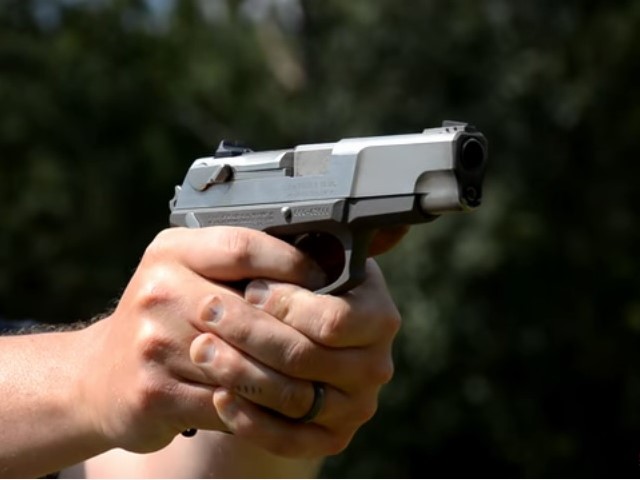
Ruger P90
The Ruger P90 was introduced in 1991 as the company’s first attempt at a .45 ACP, and was in direct competition with Sig Sauer’s P220 (which I carried as a LEO), Smith and Wesson’s 4500 series, and to a lesser extent Glock’s G21 that came out the same year. The P90 was produced until 2010. It was not a 1911, but instead, followed the times.
Then there was the P97, which was essentially a P95 chambered in .45 ACP, and similar to the P90. It was only available in de-cocker only and double-action only versions. The P97 was manufactured from 1999 to 2004. Again, it was not a 1911 but a product of the times. The Ruger P345 was the next in line.
The P345, released in 2004, incorporates an integrated keyed lock that locks the safety in the safe position, a loaded chamber indicator, and a magazine disconnect that blocks the firing pin when the magazine is removed. It has a polymer frame design (narrower than the double column derived P95 and P97) and low-profile safety levers. It did not feature an ambidextrous slide release or magazine release. Both controls are designed for a right-handed shooter. A variation, the model P345PR, adds a Picatinny rail to the frame for mounting lights and other accessories. The P345 was discontinued in 2013 and replaced by the SR45. Again, neither is 1911-based but ‘sign of the times’ pistols, although Ruger may have attempted to pull off a 1911-esque pistol with the striker-fired SR45 There was definitely something missing – a return to the tried and true combat pistol.
When Sturm, Ruger & Company introduced a line of 1911 pistols, known as the SR1911 series, in 2011, I knew that the pistols were going to be excellent examples of a 1911-based pistol, given Ruger’s propensity for quality and robustness. 1911 fanatics, including myself, breathed a sigh of relief as the SR1911 pistols hit the market. Not many missed the fact that the SR1911 was brought out in 2011 – the 100th anniversary of the original 1911 when it was accepted by the U.S. military. The question was how close to the original 1911 design was the Ruger going to be.
The first to arrive was the SR1911 that featured a full length 8.67″ slide with a 5″ barrel, a standard magazine capacity of 8+1, and a weight of 39 oz. The SR1911 is constructed from low-glare stainless steel and modern accoutrements like beavertail grip safety, extended thumb safety, extended magazine release button, extended slide lock lever, and NOVAK 3-dot sights. The caliber was .45 ACP. Read my review of this pistol @ https://guntoters.com/blog/2016/01/08/ruger-sr1911-model-no-6700/.
Then, the SR1911 Commander (SR1911CMD) arrived, which had a shorter overall length of 7.75″, a shorter barrel length of 4.25″, a reduced magazine capacity of 7+1 in .45 Automatic Colt Pistol chambering, and lighter unloaded weight of 36.40 oz. The SR1911CMD was constructed from low-glare stainless steel and had the same accoutrements as the SR1911. Read my review of this pistol @ https://guntoters.com/blog/2016/01/12/ruger-sr1911cmd-model-no-6702-owners-review/.
Following the SR1911 Commander, the SR1911 Lightweight Commander (SR1911CMD-A) soon arrived with the same overall length of 7.75″, shorter barrel length of 4.25″, same magazine capacity of 7+1, and an even lighter unloaded weight of 29.3 oz, thanks to its frame being constructed from lightweight anodized aluminum, rather than stainless steel. The SR1911 Lightweight Commander; however, was a two-tone pistol that made distinguishing the Lightweight Commander from the all stainless-steel Commander quite easy. Again, the accoutrements of the SR1911 were carried forward, but with a twist when a Titanium feed ramp to prevent damage to the frame, as was common to some 1911 pistols when firing hollow-point ammunition, was incorporated into the frame’s design. My review of this pistol can be read at https://guntoters.com/blog/2015/08/25/rugers-sr1911cmd-a-is-an-a-winner/.
Other ‘Government’ and ‘Commander’ models in different calibers arrived on the scene with the exception of one; an “Officer” style that needed to be a shorter version of the “Commander” and like that of the Colt Officer Model that was introduced in 1985 in response to competitors bringing to the table small 1911 pistols (Star PD that I regret selling) and Detonics come to mind).
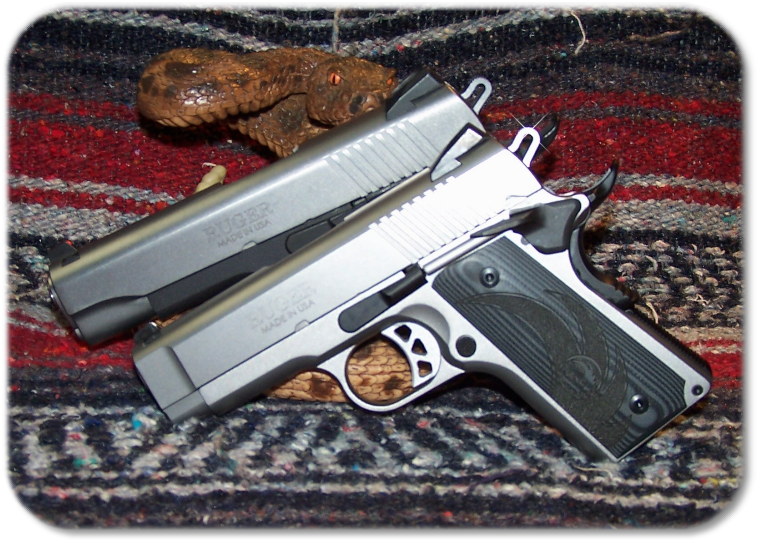
The ® SR1911® Officer-Style Pistol (front) with the Ruger SR1911CMD (rear).
Having each of the aforementioned Ruger SR1911 pistols, I (and many others) wondered when (or if) Ruger was going to come out with an “Officer” version; a compact version of the 1911. It would only seem logical for Ruger to do so. It would be a while, but Ruger finally released an “Officer” version in 9mm this year (2018) and then one in my favorite caliber, the .45 ACP. While it wasn’t a “Slab-Side” like the original John Browning design (more on that later), the principle design was close enough, the barrel length was 3.6-inches, and after much contemplation on the new design I felt it was good that Ruger put a modern twist on the original design – and then some.
The Ruger® SR1911® Officer-Style, Model 6762, takes a little getting used to if you are a ‘traditionalist’ when it comes to 1911-based firearms, and you may say that a 1911-based pistol is not supposed to look like the Ruger® SR1911® Officer-Style pistol. I felt the same way, but after handling the Ruger® SR1911® Officer-Style under fire, I can say that it is all 1911 with modern conveniences and better performance than with the original. I can say that because I carried a Colt 80-series Officer Model off-duty when I was a LEO in a past life. The original Colt was, indeed, a close-up ‘belly’ gun, as I struggled to qualify with it at distances beyond ten yards. (Note that I was carrying a Colt Series 80 Government Model as my duty carry and had no problems qualifying with it.)
My first attempt to locate a Ruger® SR1911® Officer-Style was unsuccessful; there just did not seem to be any available through my normal channel. I chalked this up to possible the pistol was not in distribution yet, as this was right after the announcement. Finally, though, I was able to get my hands around one and that is what this review is all about. With that said, this review would also serve as a comparison to other ‘Officer” model 1911-based pistols such as the Rock Island 1911 Standard CS ($618 MSRP), the RIA 1911 Ultra CS ($731 MSRP), and the Springfield Range Officer Compact ($924 MSRP). What do you get for the price difference between these models and the Ruger® SR1911® Officer-Style ($979 MSRP)?
What follows are the basic specifications for the Ruger® SR1911® Officer-Style pistol.

 The first, and most obvious, is the design of the slide on the Ruger® SR1911® Officer-Style pistol. Rather than the barrel shroud being flat-sided to the muzzle, as with most 1911-based pistol, Ruger has opted to chamfer the slide and make the slide thinner at the end of the frame, which give the appearance of a ‘stepped’ look instead of the more ‘traditional slabside’ look. However, it does serve a purpose. Rather than milling slots at the front of the slide for “Pinch Checking” of the pistol that is done in some 1911-based pistols, the chamfer accomplished the same purpose, and in my opinion, looks better than milled slots.
The first, and most obvious, is the design of the slide on the Ruger® SR1911® Officer-Style pistol. Rather than the barrel shroud being flat-sided to the muzzle, as with most 1911-based pistol, Ruger has opted to chamfer the slide and make the slide thinner at the end of the frame, which give the appearance of a ‘stepped’ look instead of the more ‘traditional slabside’ look. However, it does serve a purpose. Rather than milling slots at the front of the slide for “Pinch Checking” of the pistol that is done in some 1911-based pistols, the chamfer accomplished the same purpose, and in my opinion, looks better than milled slots.
The second thing that should be obvious with the Ruger® SR1911® Officer-Style pistol is that it has a bushing-less slide, which is common to all ‘Officer’ model 1911-based pistols. The 3.6-inch barrel is a ‘Bull’ barrel that incorporates the traditional swing link and locking lug features and incorporates 6 grooves and a 1:16 RH twist rate. The ‘Bull’ barrel also adds some weight over straight barrel designs.
Ruger ‘endows’ the slide in its usual fashion by providing laser etchings. The left side of the slide has RUGER MADE IN USA nicely laser etched, whilst the right side of the slide contains the nicely laser etched Ruger logo.
The barrel is also a ‘full-ramp’ barrel to ensure that cartridges load properly.
Obviously, a Full Length Guide Rod (FLGR) and bushing is used, but the Ruger® SR1911® Officer-Style again strays from convention with the use of a triple-recoil spring arrangement, and they are not captive. The Guide Rod Bushing is also stainless-steel.
The slide incorporates a drift-adjustable Novak 3-dot sight system, which I prefer over the fiber front sight of the RIA Ultra CS and Springfield Range Office Compact, and also the plain ramp sight of the RIA Standard 1911 CS model.
The frame offers an ‘Officer-size’ grip, which is slightly shorter than the ‘Commander-Style’ frame. Unless you have very large hands, all fingers can be wrapped around the grip without hanging off. The frame does house a capacity of 7+1 rounds of the .45-caliber cartridge in a stainless steel magazine, which is the same capacity as with the ‘Commander-Style’ but one less than with the ‘Government-Style.’ An 8-round capacity magazine can also be used – with some overhang at the bottom. I normally carry a flush magazine in the ‘Commander-Style’ version pistol with two 8-round magazines as backup and would do the same with the ‘Officer-Style’ pistol.
The low-glare stainless finish on both slide and frame is excellent while black sights and controls (extended slide lock, extended magazine release button, over-sized beavertail grip safety, skeletonized, and extended thumb safety) add a nice contrast.
RUGER SR1911, the origin of the manufacturer, and the serial number are laser-etched into the ride side of the frame.
The mainspring housing is metal, round, and checkered. The front strap is not checkered but is round.
Two stainless-steel magazines are provided with the pistol, have the Ruger logo stamped in the base plate, and have two holes for mounting a bumper pad.
The ejection port is over-sized and flared to ensure those fired cases are expelled from the pistol with authority.
 The grip panels are the popular G10 type with mild texturing and a stylized Ruger Eagle and emblem motif that not only looks good but aid in holding on to this beast. However, the grip panels have an edge to them that I don’t particularly care for; especially at the bottom rear of the right grip panel, which cuts into my hand. The grip panels are replaceable and will be replaced with my usual Hogue Rubber Wraparound Finger-Groove grips. Note that the frame only accommodates grip panels for the ‘Officer’ model 1911 (2 11/16” grip screw spacing). On a side note, Hogue does not recommend their Exotic hardwood wrap-around grips for the ‘Officer” model pistols and, in fact, do not carry them, although the Hogue Rubber Wraparound Finger-Groove Grip is available and works well with my RIA 1911 Standard CS pistol.
The grip panels are the popular G10 type with mild texturing and a stylized Ruger Eagle and emblem motif that not only looks good but aid in holding on to this beast. However, the grip panels have an edge to them that I don’t particularly care for; especially at the bottom rear of the right grip panel, which cuts into my hand. The grip panels are replaceable and will be replaced with my usual Hogue Rubber Wraparound Finger-Groove grips. Note that the frame only accommodates grip panels for the ‘Officer’ model 1911 (2 11/16” grip screw spacing). On a side note, Hogue does not recommend their Exotic hardwood wrap-around grips for the ‘Officer” model pistols and, in fact, do not carry them, although the Hogue Rubber Wraparound Finger-Groove Grip is available and works well with my RIA 1911 Standard CS pistol.
The rear slide serrations are deeply cut and afford the best of grip for pulling the slide to the rear. A ‘peek-a-boo’ (aka, Inspection Port) slot is cut into the top rear of the chamber that provides an observation point for determining if the pistol has a cartridge chambered. The 9mm version of this pistol has ‘Chevron’ serrations, but I prefer the slant cut serrations to ones on the 9mm.
The skeletonized hammer is also done in a black finish with serrations to ensure that the thumb is in good contact with the hammer should it be placed in cocked or lowered position. The hammer spur fits nicely into the extended beaver-tail grip safety’s well when in the cocked position.
The aluminum, serrated and skeletonized trigger is adjustable for over-travel, but no adjustment was necessary on this version. Trigger pull weight on this particular model is about 4.25-pounds with a slight take-up, a clean break and virtually no over-travel. The trigger take-up is more of a ‘step’ than a smooth pull. There is a slight click when the trigger is pulled to the wall. The click is tactile, as it would not be heard with proper ear protection worn, and probably would not even be noticeable under fast fire. I have not found this take-up ‘click’ on any other 1911 and it may only be something with this particular pistol. I will say that I like it, though.
Being all stainless, the Ruger® SR1911® Officer-Style weighs in at 31 ounces (dry); a scant 1.7 ounces over my Lightweight Commander-Style SR1911, and 4.56-ounces lighter than the RIA Standard 1911 CS (34.56-ounces) with its 3.62-inch barrel, and 2.5-ounces heavier than the lightweight, 6-round Springfield Range Officer Compact in the same chambering with its 4-inch barrel.
The extended thumb safety is left-side only. An aftermarket ambidextrous thumb safety can be installed if desired. Both safe and off-safe position snick cleanly through the motion, although going into the off-safe position is slightly lighter in feel.
The beaver-tail safety is excellent and incorporates a “memory bump” I like to shoot my 1911-based pistol with my thumb over the thumb safety, which provides the highest grip possible. The ‘memory bump’ ensures that my hand remains in contact with the grip safety even with the high grip that I use.
Slide to frame fit is excellent with no discernible side play. The slide operates very smoothly and surprisingly easy even with a triple-spring recoil system in place. Lock-up is tight and positive.
Although I have never experienced a Plunger Tube coming off, I know people that have, and that is no longer a concern with the Ruger SR1911 line of pistols, as each has a plunger tube that is integral with the frame. My Son-in-Law recently experienced a departing plunger tube (and its contents) with a brand new RIA 1911 10mm pistol the first day of shooting. Perhaps, he should have bought the Ruger in that caliber?
For the 1911 purists among us, the Ruger® SR1911® Officer-Style is built on the ’70-Series’ model; that is, there is no trigger-actuated firing pin block that prevent the pistol from firing should the hammer take a knocking in the rest position or cocked position. Instead, Ruger uses a strong firing pin spring with a light Titanium firing pin that accomplishes the same purpose but in a different manner. Most prefer the ‘70’ series trigger, as I do, although I can say that I never encountered issues with my ’80-series’ Colt Government model when carried during my time as a LEO; it worked just fine for me when I needed it.
The CNC-controlled machining leaves little to be desired – little in the way of tool marks, that is. Ruger has some of the nicest finishing on a production pistols as compared to what has been seen through the years with any manufacturer, in my opinion.
The Ruger® SR1911® Officer-Style has a balanced feel to it when fully stoked with ammunition. If you normally carry a full-weight ‘Government’ 1911 on a daily basis, as I do, it takes some time to acclimate to the compact nature of the Ruger® SR1911® Officer-Style, or for any compact 1911, for that matter, especially at the range. The more I handle it, the more I like it. That’s not saying that it will replace my “Government” model 1911 any time soon, however.
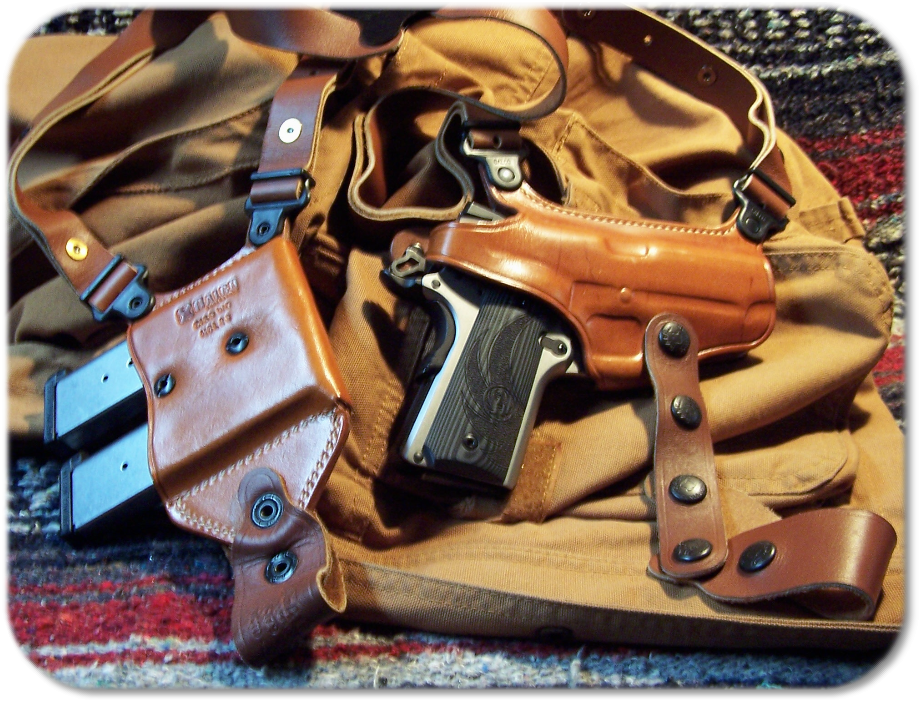
The ® SR1911® Officer-Style Pistol in the Galco Miami-Classic II Shoulder Rig.
The 1911 still remains one of the thinnest pistols to carry whether it is carried concealed or open. I normally use an IWB holster intended for a ‘Government’ model due to the added depth and stability of the holster, even when I am carrying a ‘Commander’ or ‘Officer’ length 1911. The Ruger® SR1911® Officer-Style feels right at home in my Black Arch hybrid IWB holster, an IWB all leather holster from Falco Holsters, a Cumberland – Leather Concealed Carry Holster from Simply Rugged Holsters, or a Galco Miami Classic II shoulder holster that I prefer in the cool/cold months under layers of clothing. And, the muzzle and front sight are fully protected with all of these holsters.
Disassembly/Assembly
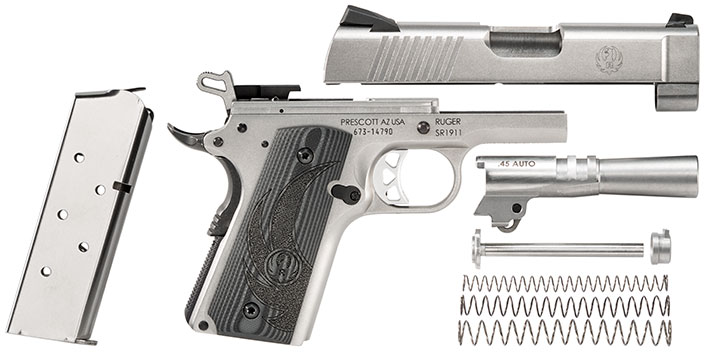 Disassembling and assembling the Ruger® SR1911® Officer-Style pistol strays a bit from conventional, short barreled 1911-based pistol, even with those that have full-length guide rods.
Disassembling and assembling the Ruger® SR1911® Officer-Style pistol strays a bit from conventional, short barreled 1911-based pistol, even with those that have full-length guide rods.
When disassembling the ‘Officer” model 1911-based pistols such as the; Rock Island 1911 Standard and Ultra CS and the Springfield Range Officer Compact, a bent paper clip is used to hold the guide rod, guide rod bushing, and recoil spring together thus forming an ‘assembly’ that serves to remove spring tension on the slide
In the case of the Ruger® SR1911® Officer-Style pistol; however, no bent paper clip is required. This means that you remove the Slide Lock Lever under spring tension. And, what I am about to convey goes against the instructions in the instruction manual that is provided by Ruger with the Ruger® SR1911® Officer-Style pistol.
Disassembly
Obviously, the first step is to make the pistol safe; magazine out of the firearm and no ammunition chambered. Once the firearm is guaranteed to be empty and safe, you move to the next step.
With the hammer to the rear, the slide is pulled slightly rearward to unlock the slide. Then, while supporting the slide with the right hand, the disassembly notch is lined up with the slide lock pin. I normally grip the pistol as I would when disassembling a pistol like the Glock; thumb around the beaver tail safety and fingers holding the slide in place. Note that there is a possible ‘pinch point’ at the ejection port and barrel and the fingers of the hand need to be away from this area while holding the slide to the rear.
Next, the slide lock is removed in the usual fashion; align the disassembly/assembly notch with the slide lock pin and then remove the slide lock assembly from the frame. Note that the slide is still under spring tension. The slide is then slowly allowed to move forward, while keeping any fingers away from the ejection port, until all spring tension is gone. Finally, the slide is removed from the frame.
Holding the slide upside down, the swing link is placed to the rear, the base of the guide rod is lifted up (again, under spring tension) and over the swing link housing. Slowly allow the spring tension to release and then remove the guide rod and recoil springs from the rear.
The guide rod plug (or bushing) is then pushed in from the front for removal, the swing link is pushed all the way forward, and the barrel is removed from the front of the pistol, as with any 1911.
Assembly
The first consideration when assembling the Ruger® SR1911® Officer-Style pistol, after inserting the barrel into the slide, is to ensure that the guide rod bushing is properly installed. The guide rod bushing is ‘keyed’ to the barrel by a ‘flange’ that meets the contour of the barrel and installs from the rear.
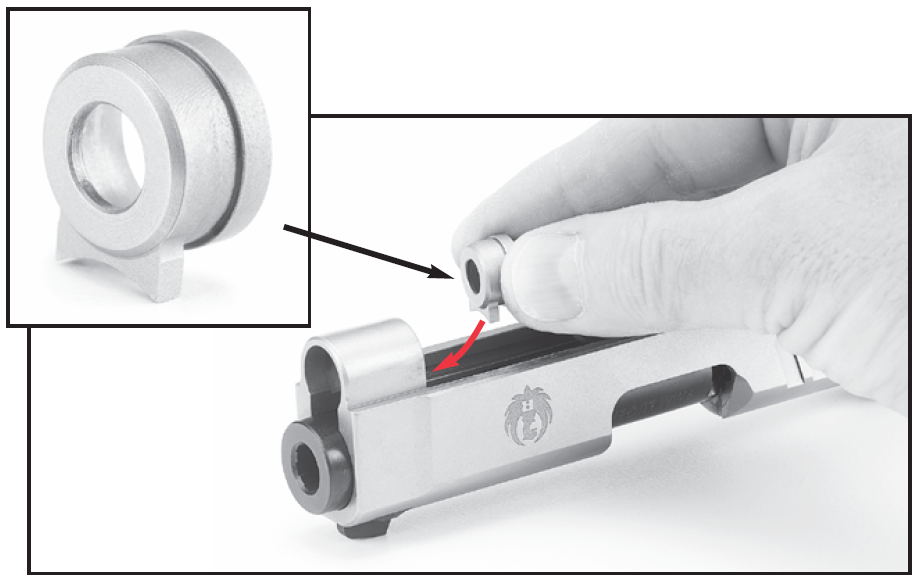 Once the guide rod bushing is properly installed, the guide rod and recoil springs can be installed.
Once the guide rod bushing is properly installed, the guide rod and recoil springs can be installed.
Place the swing link to the rear and push the guide rod and springs into the guide rod bushing while pressing down on the base of the guide rod to engage the swing link carriage.
Once the guide rod and recoil springs have been installed move the swing link to the up position.
Slide the slide onto the frame and align the swing link opening with the assembly hole in the frame. Note that this action places the slide under spring tension and the slide must be supported, as was done in the disassembly to prevent the slide from moving forward.
Insert the slide lock assembly and lock into place as with any 1911.
Cycle the pistol several times and check for proper operation.
The Defining Moment – Range Day
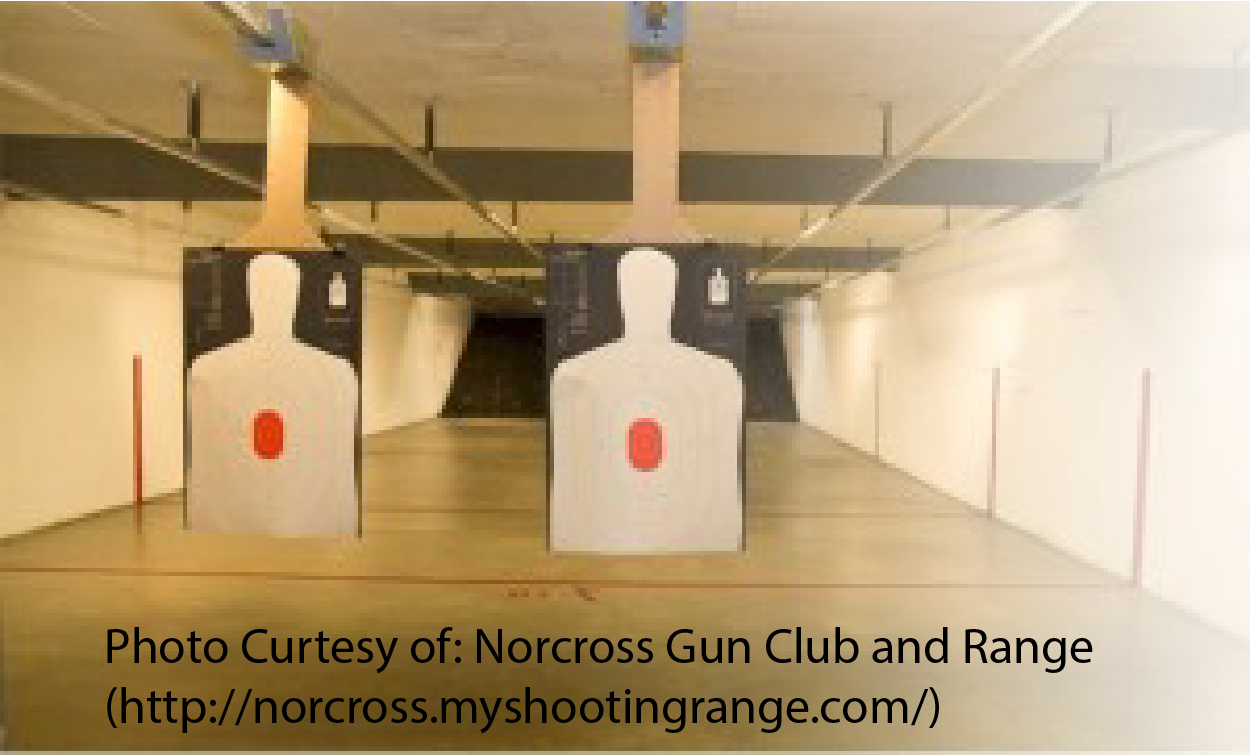 Regardless how nice a firearm seems to be, the true test is shooting it.
Regardless how nice a firearm seems to be, the true test is shooting it.
After a thorough checkout, cleaning, and lubrication, the Ruger® SR1911® Officer-Style pistol was ready for the range.
I had planned on first shooting some Perfecta 230-grain FMJ for basic functioning and relative accuracy. Then, I wanted to shoot a magazine of Sig Sauer Elite V-Crown 200-grain and a magazine of Sig Sauer Elite V-Crown 230-grain. The latter provides excellent accuracy through my EDC, the RIA 1911 FS Tactical, and is what I carry for SD purposes, and it would be interesting to see what it would do through the Ruger® SR1911® Officer-Style pistol.
I have to admit that I have a liking to the full-size Government Model 1911, as it can do what I need for it to do from near to distances out to 50-yards, if I do my part. It is assumed that the shorter ‘Officer’ model is more of a ‘belly’ gun appropriate to UCAP (Up Close and Personal) distances. I have to admit that I felt the same with my experience with the Colt Officer Model at distances greater than 10-yards; I just did not have the confidence in it as I did my Colt Government model 1911, with its 5-inch barrel, for taking an accurate shot at even 10 yards.
My RIA CS doesn’t do much to change that, nor does the Springfield Range Officer Compact, nor does the Ruger® SR1911® Officer-Style pistol. To me, the 5-inch barrel has the advantage in both velocity and accuracy departments. I was hoping that the Ruger® SR1911® Officer-Style pistol would change my attitude toward short-barreled 1911-based pistols, even though the ‘Commander’ with its 4.25-inch barrel did impress me as being equal to the ‘Government’ at combat distance. Most of my difficulties are with my shooting capabilities and not what is being shot. With that said, let’s take a look at some issues that cropped up.
There were multiple failures to completely go into battery with the Perfecta 230-grain FMJ round, although they feed fine in my other 1911s. Looking at the cartridge, there was a distinct different in case thickness between the Perfecta ammunition and the Sig Sauer ammunition. Taking measurements of the chamber, the case O.D. and case length for both the Perfecta and Sig Sauer ammunition revealed no abnormalities that would cause a failure to go completely into battery. A cartridge of each cartridge was dropped into the chamber (after cleaning) and both seated at the same depth. The chamber measured 0.4795-inch with the cartridges measuring 0.4695-inch (O.D.). Burnt powder build-up in the chamber (Perfecta and Fiochhi are not the cleanest burning of powders) could also have been the cause.
The Fiochhi 230-grain FMJ fared better, but one round failed to completely go into battery.
Of the above, I could only attribute it to the pistol being new and not yet broken in. Only more shooting will tell if there remains an issue. With that said, the Ruger® SR1911® Officer-Style pistol operated flawlessly with Sig Sauer defensive ammunition and that, to me, is what really counts.
There were no failures to extract or eject.
There were no feeding issues with Sig Sauer V-crown 230-grain JHP, 200 – grain JHP, or 185-grain JHP. The 230-grain had the least felt-recoil of the three and accuracy was about the same for all three at combat distance (7-yards).
The first shot revealed that the Ruger® SR1911® Officer-Style pistol is snappy little critter, but is manageable with the proper grip and adequate grip panels. Some say that with short-barreled 1911s like this one, the 185-grain fodder is the best choice to use for velocity sake. The 185-grain cartridge is, of course, lighter and faster than the 230-grain cartridge. However, I found the 230-grain cartridge the softest recoiling of them all.
The pistol was shooting left of POA. Both sights seemed aligned with the center of the slide. I let my good friend, who I will call Mike, because that’s his name, shoot the pistol. Mike normally carries a Kimber with a 3” barrel so he is used to shooting short-barreled pistols. The Ruger® SR1911® Officer-Style pistol shot left with him, as well. With that said, only more trigger time with the pistol, and a new set of grips that actually fit my hand, may help immensely. What Mike’s problem was I can’t tell you? He had just finished shooting a playing card in half (edgewise) with a Mossberg rifle chambered in .308 on a first, cold-bore shot (what, again?) so I know that it wasn’t him shooting left.
The summary of this range day is that the Ruger® SR1911® Officer-Style pistol is definitely a ‘belly gun” at this point and some rear sight drifting may be in order. Hopefully, today’s shooting results will not be long-term.
Issues with the Pistol
I really have no issues with the Ruger ® SR1911® Officer-Style pistol except two that are personal issues – the grip panels and the front sight. The stock grip panels will be exchanged with something of a little more girth like the Hogue Rubber Wraparound Finger Groove grips. With a compact pistol like this, you need the entire gripping surface that you get and the Hogue Rubber Wraparound Finger Groove grips provide that for my hand.
The front sight is one of three dots that comprise the sight system. The front sight is a white dot, which will be changed to a different color. For me, fluorescent green seems to work well with my eyes. A dot of fluorescent green with a dab of clear did the trick.
The previously-mentioned ‘click’ of the trigger during take-up disappeared. Apparently there was a small burr on the left side of the trigger well and pulling the trigger seemed to have smoothed that out. Later, a dab of ‘Alpha Sauce’ was applied to the trigger area and things smoothed up considerably. Trigger pull weight averaged at 5 pounds and 13.6 ounces.
Wrapping Things Up
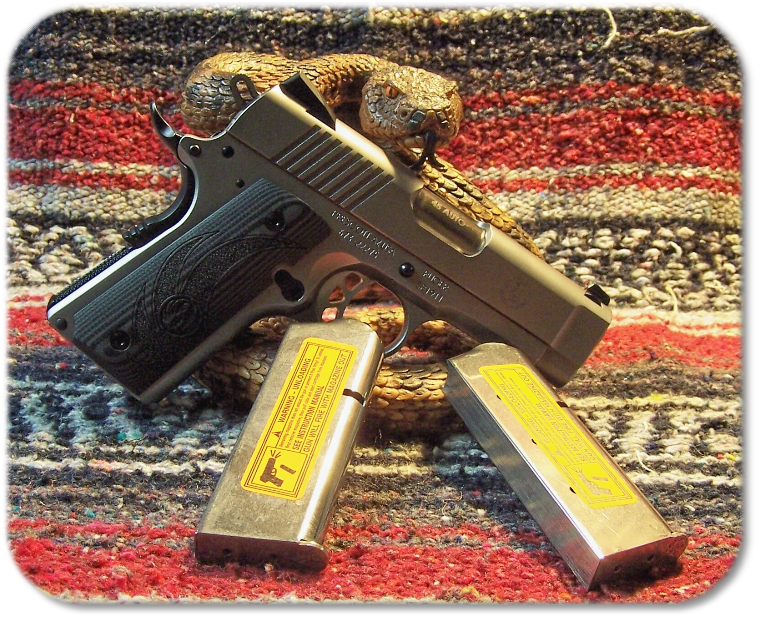
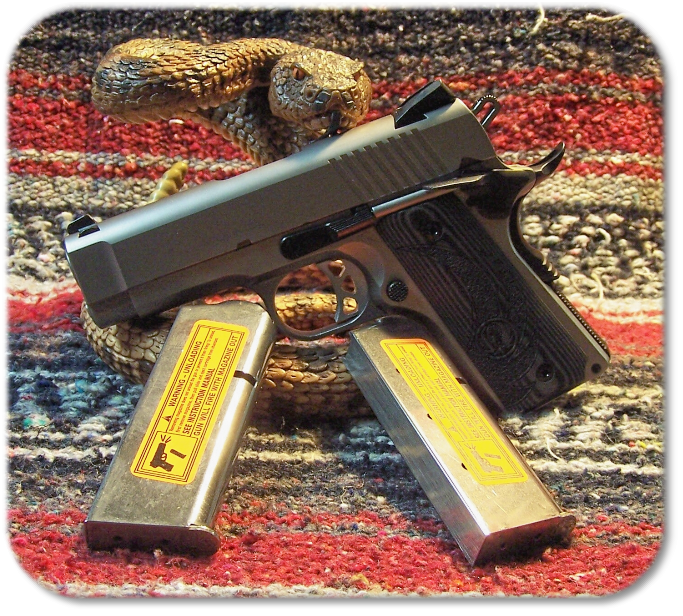 To borrow a phrase from Jeff Quinn at GunBlast.com, the Ruger® SR1911® Officer-Style pistol in .45-caliber is a ‘dandy’ little pistol that is chambered in a major caliber and is ready to rock-n-roll out of the box with the proper ammunition.
To borrow a phrase from Jeff Quinn at GunBlast.com, the Ruger® SR1911® Officer-Style pistol in .45-caliber is a ‘dandy’ little pistol that is chambered in a major caliber and is ready to rock-n-roll out of the box with the proper ammunition.
My first SR1911 was the ‘Government-Style’ model, which was soon followed by the ‘Commander-Style,’ which led to my EDC rotation of the ‘Commander-Style Lightweight’ pistol that has proven to be an excellent 1911-based pistol. The acquisition of the ‘Officer-Style’ provides me with a full family of Ruger SR1911 pistols from which to choose. Each have proven that Ruger was right to get involved with the 1911 pistol and can compete with any 1911-based pistol on the market.
If the version in .45 ACP does not fit your fancy, it is also available as a 7+1 round light-weight Officer’s version in 9mm (Model 6758). But, for my money, if I am only able to carry 7+1 cartridges in my pistol (or even less, as with the Springfield Range Officer Compact), I want them big.
In my opinion, Ruger has done a fine job with the line of SR1911-based pistols in keeping with the tradition, but include conveniences that we now expect in a modern-day 1911. Or, if the compact is not your style, you might want to consider the Ruger SR1911CMD or the lightweight SR1911CMD-A; both of which are excellent handguns (read my comparison of them at: https://guntoters.com/blog/2016/07/06/ruger-sr1911cmd-vs-sr1911cmd-a-for-cc/).
The John Moses Browning designed 1911, although adopted by the Army on March 29, 1911, started life earlier than that. It is in current use by more countries than I have toes and fingers (including thumbs) and seems only to be gaining in popularity rather than diminishing even though striker fired pistols dominate the market. We are no longer saddled with a basic “Government Model’ 1911, as advancement of metallurgy, cast forging, and CNC manufacturing, let alone more modern conveniences like extended controls, are now standard. A high-quality 1911-based pistol can be purchased at a reasonable price. Unless a 1911-based pistol comes from a custom shop, most are considered ‘entry level’ pistols. The Ruger® SR1911® Officer-Style pistol would fall into that category, I suppose. While it may be considered an ‘entry-level’ pistol, it is definitely not for beginners (I have purchased a couple of 1911-based pistols from first-time shooters that were intimidated by them).
At the beginning of this review I stated that this article may also serve as a comparison between the Ruger® SR1911® Officer-Style pistol and several other “compact’ models that I am familiar with. So, how does the Ruger® SR1911® Officer-Style pistol stack up against the Rock Island 1911 Standard CS ($618 MSRP), the RIA 1911 Ultra CS ($731 MSRP), and the Springfield Range Officer Compact ($924 MSRP). What do you get for the price difference between these models and the Ruger® SR1911® Officer-Style ($979 MSRP), or possibly even a Kimber or a Colt?
While I can recommend the Ruger® SR1911® Officer-Style pistol, I also realize that there are folks who prefer manufacturers other than Ruger, and there are plenty of other manufacturers of 1911-based pistols. Virtually all 1911-based pistols can be found with the same features in one form or another. Rock Island Armory has made a name in reasonably-priced 1911-pistols with excellent quality, and I have been carrying a RIA 1911 FS Tactical for several years now with no complaints.
What I can tell you, from experience, is that the Ruger SR1911 series of pistols have ranked high in my book for many years and in several areas. The Ruger SR1911 series of pistols are not as reasonable in cost as the RIA models, or as expensive as a Dan Wesson, Sig Sauer, or some others. With that said, if you like compact 1911-based pistols, the Ruger® SR1911® Officer-Style pistol’s price of admission is worth the show.
UPDATE 11/21/2018
A new Hogue Rubber Wraparound finger Groove grip is now mounted on the Ruger® SR1911® Officer-Style pistol with Wilson Combat stainless steel grip screws, which adds some contrast to the grip that adds contrast to the pistol..
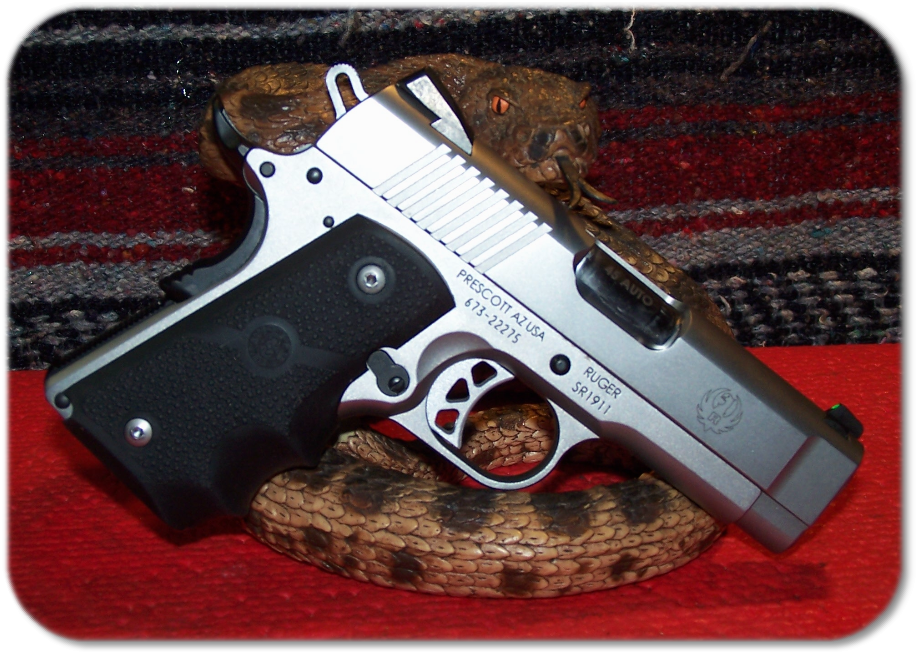
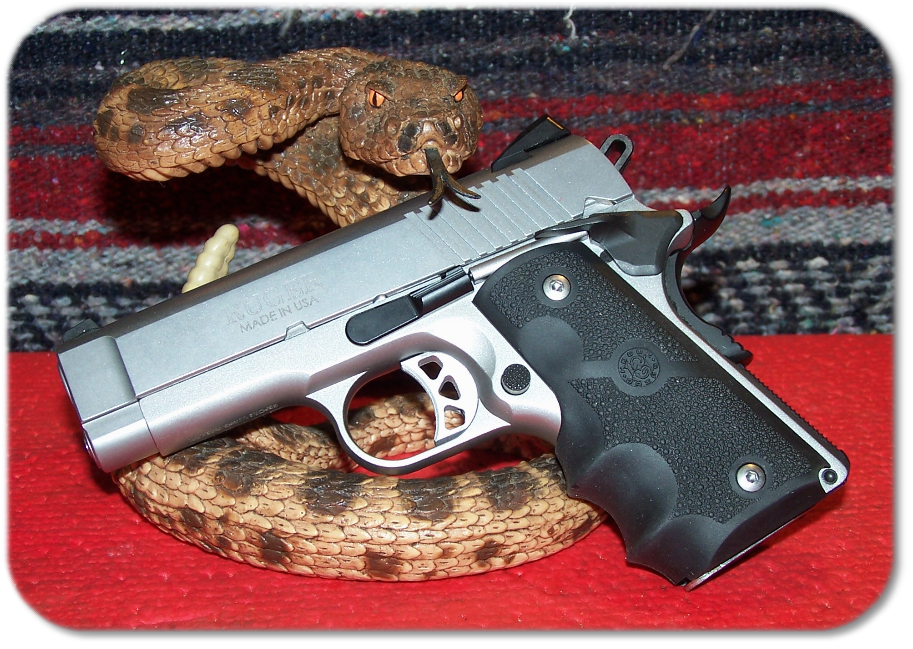
These really fill in the grip area nicely, and for my hand, provide a much better grip on the pistol than what I had with the stock Ruger grip panels.
Also, a dab of fluorescent green was added of the front sight (shown below) and that really made a difference for sighting with these old eyes.

Update 11/25/2018 – Range Day, Part II
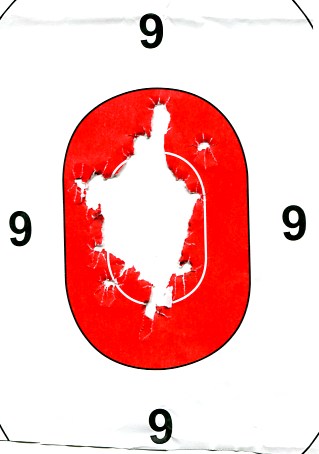
40-rounds, 7-yards, Offhand, Various Ammunition
Being dissatisfied with the first range day shooting the Ruger® SR1911® Officer-Style pistol, it was time to try again.
This time, I had ‘borrowed two 7-round ACT magazines from the RIA 1911 ultra CS, which have base pads that also adds a little ‘pinky’ real-estate to the grip area, to provide an additional two magazines to test with the pistol. These magazines operated flawlessly with the RIA and I had confidence that they would serve well in the Ruger. However, I did not think that the magazines were the cause of cartridges not going completely into battery, so I also applied a very thin coating of a new product that I had received to evaluate – Alpha Sauce from Extant Labs, which would add some ‘slickness’ to the chamber.
I was going to; once again, try the Perfecta 230-grain FMJ that had failed to go into battery on numerous occasions the first range day. I also had some Fiochhi 230-grain cartridges where all, except one, went into battery just fine. Adding to the pot was some Monarch (PPU) 230-grain ammunition. In addition, and since I had some left over from the previous range session, the Sig Sauer 185-grain Elite Performance Ammunition V-Crown JHP and Sig Sauer 200-grain Elite Performance Ammunition V-Crown JHP was put to the test.
A new Hogue Rubber Wraparound Finger-grooved grip replaced the stock Ruger grip panels, and a dab of fluorescent green had been added to the front sight to aid in aiming (see previous update). The rear sight had also been tapped gently and slightly to the right to (hopefully) bring the left-shooting pistol back to center (while this technique does not work on Democrats or RINOs, it has been proved successful with firearms).
The ‘click’ of the trigger during pre-travel had disappeared and I was looking forward to a great range day with the Ruger® SR1911® Officer-Style pistol. Hopefully, the stars would align, the heavens would open, angels would sing, and John Browning would be smiling.
While this was not going to be an exhaustive or extensive test, I needed to see what was going to work in this compact 1911-based pistol during this range session. If a pistol is going to be carried for defensive purposes, it has to be reliable 110% of the time with any ammunition. Penetration and expansions are just byproducts of shot placement and shot placement, while not guaranteed, begins the chaos that results from where the round impacts the human body. But first, the round has to exit the barrel of the chosen firearm.
After each group of cartridges was fired, offhand, a Bore-Snake was sent through the barrel to keep the chamber, barrel, and feed ramp as clean as possible during the session.
- Perfecta 230-grain FMJ:
- As before, multiple failures to go into full battery.
- Fiochhi 230-grain FMJ:
- No issues. Hottest cartridge of the cartridges fired.
- Monarch 230-grain FMJ:
- No issues
- Sig Sauer 185-grain JHP:
- No Issues
- Sig Sauer 200-grain JHP
- No issues
The addition of the Hogue Rubber Wraparound Finger Groove grip provided much more control over the pistol and also reduced felt recoil, while the fluorescent green front sight provided better aiming for my eyes.
The pistol is still shooting slightly left, but a few more light taps on the rear sight will cure that issue.
After today’s range session I can definitely say that the Ruger® SR1911® Officer-Style pistol is carry worthy as a defensive tool.
Update 11/07/2020
Well, it has been almost two years to the day that the Ruger SR1911 Officer had received any attention. While I had updated the Ruger SR1911 Officer with Hogue Rubber Wrap-a-round grips, and while they are excellent grips for holding on to the pistol, my penchant for wood grips overcame my sense of utility.
The 1911 Compact/Officer Fingergroove Super Walnut Checkered/Stipple (Item # CO-FG07-STP) grip panels really captured my attention. Mounted with custom screws from Cool Hand Grips, the Ruger SR1911 Officer is now a personalized pistol (almost) tailored to my exacting standards for a carry pistol.
While I prefer solid wood grip panels, the laminated grip panels from Altamont add a dimension of layering that cannot be achieved by Mother Nature. The detail is impeccable, as is the fit to the hand. While the grip panels are not thicker than a standard 1911 grip panels, the finger grooves add a tad more grip area and better finger purchase, which my hand prefers.
What follows is the result of this upgrade.
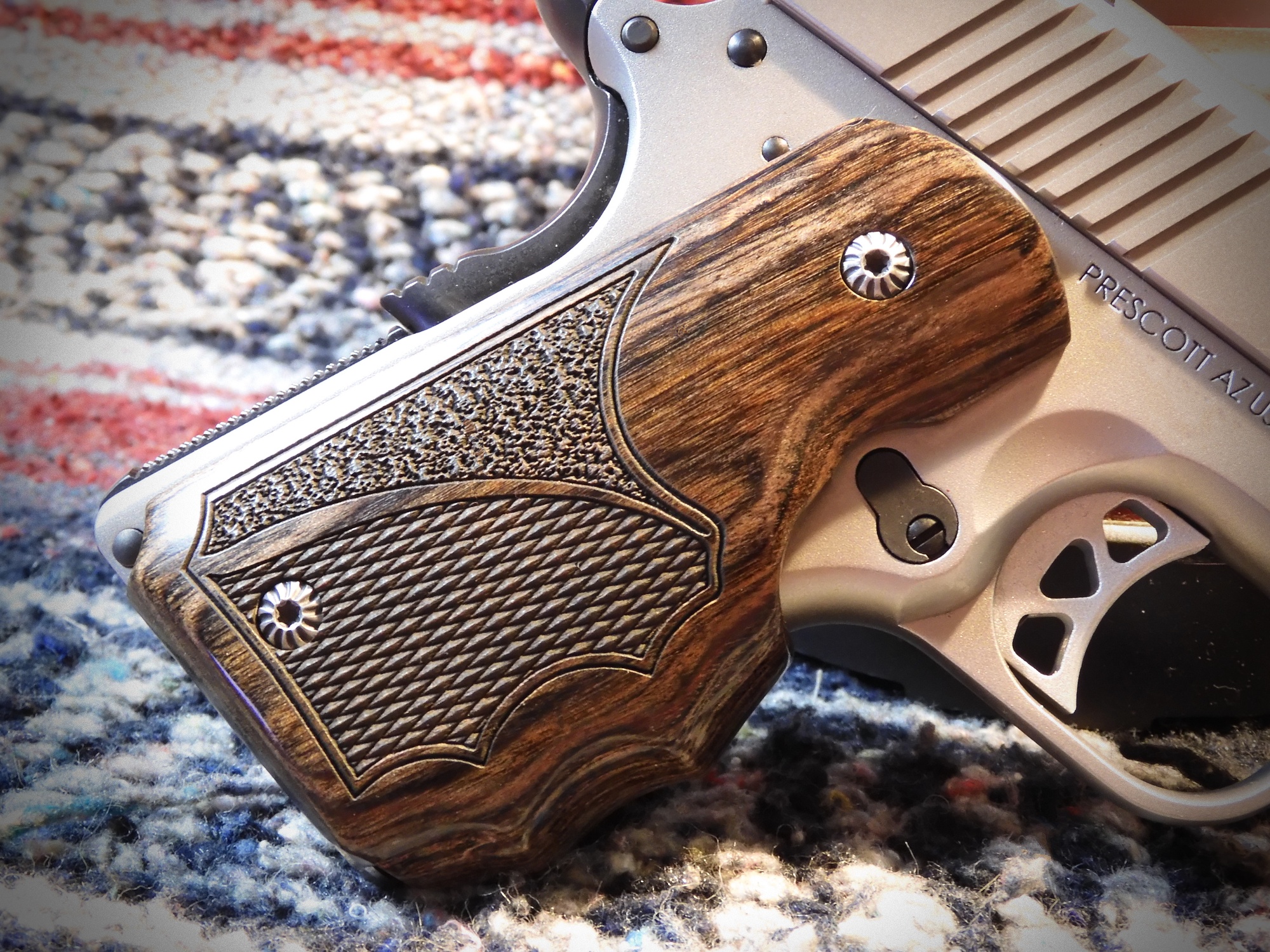



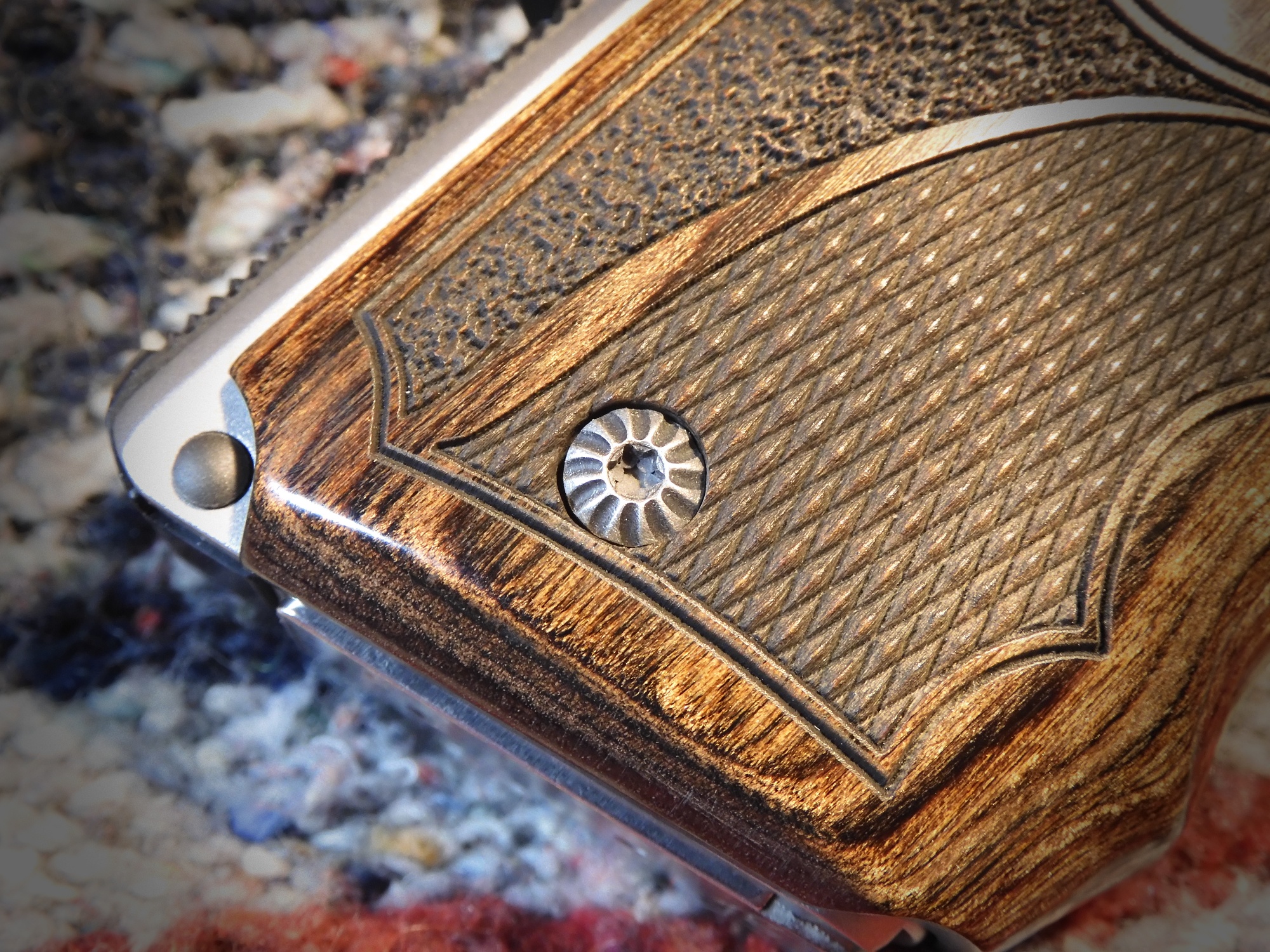
Resources
- Ruger ® SR1911® Officer-Style: https://ruger.com/products/sr1911OfficerStyle/specSheets/6758.html
- Ruger® SR1911® Officer-Style 45 ACP Compact Semi-Automatic Pistol – Gunblast.com (Boge Quinn, the late Jeff Quinn’s Brother): https://www.youtube.com/watch?v=XAs9dyHcObU
- Altamont 1911 Compact/Officer Fingergroove Super Walnut Checkered/Stippled grip panels: https://www.altamontco.com/pistol-grips/1911-compact/fgrooves/
- Cool Hand Grip Screws: https://coolhandgear.com/catalog/category/screws/
![]()


2 Responses to Ruger SR1911 Officer-Style 1911, .45 ACP Model Number: 6762